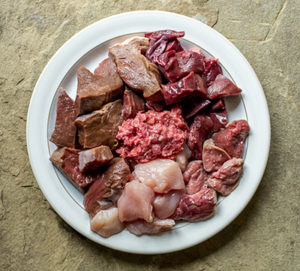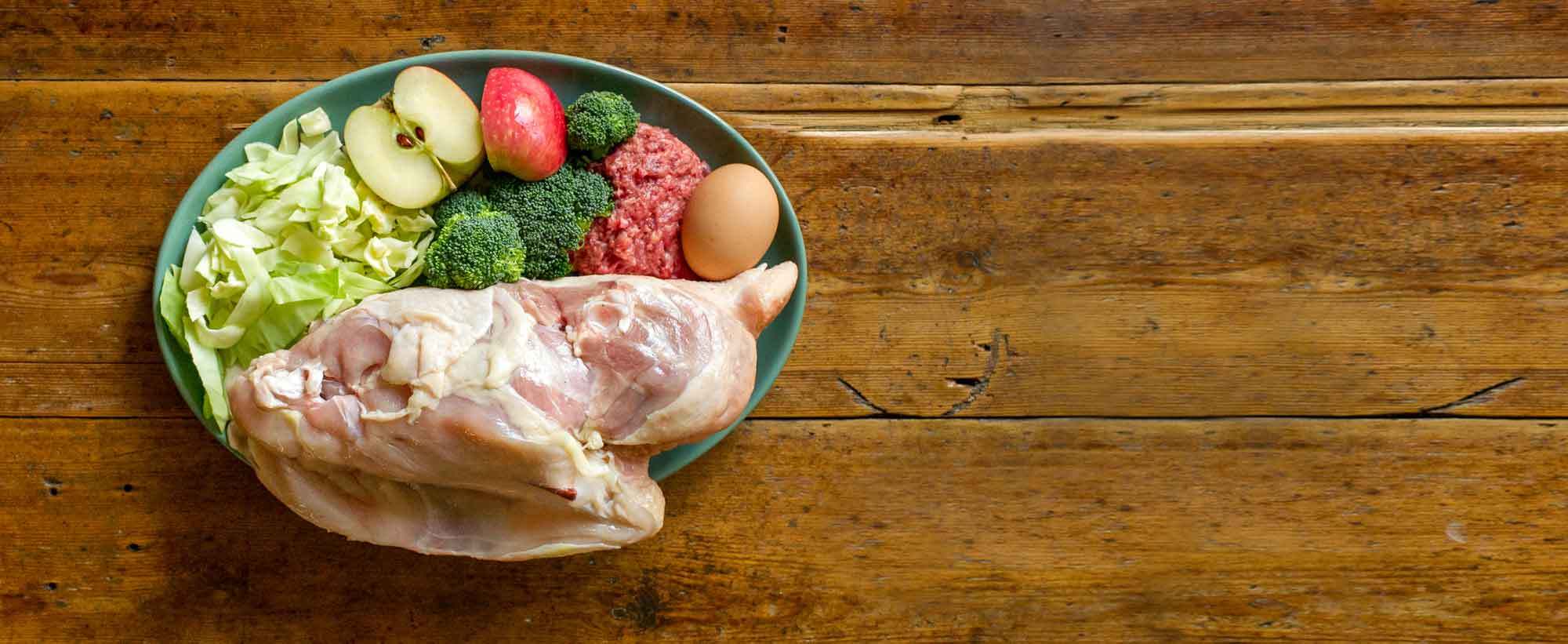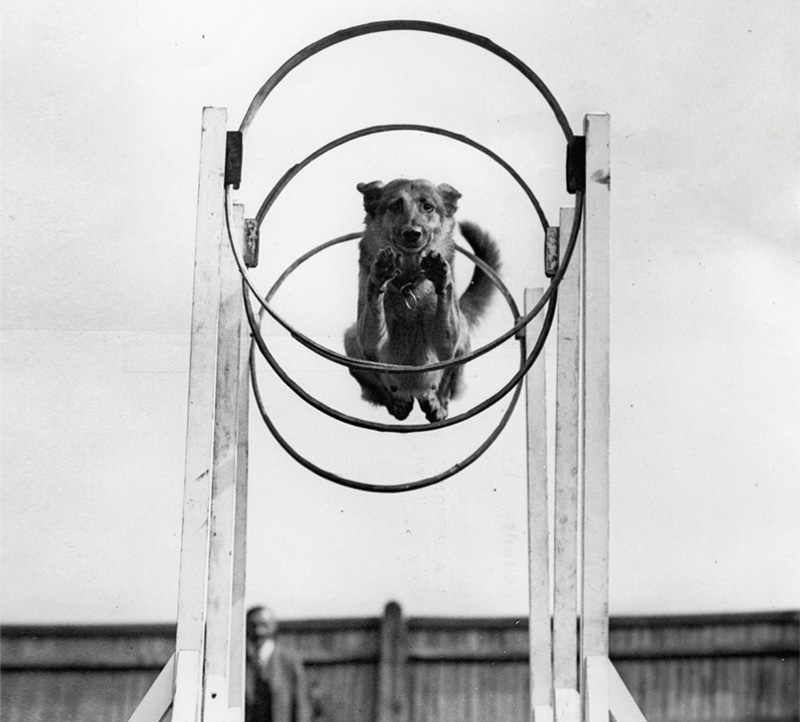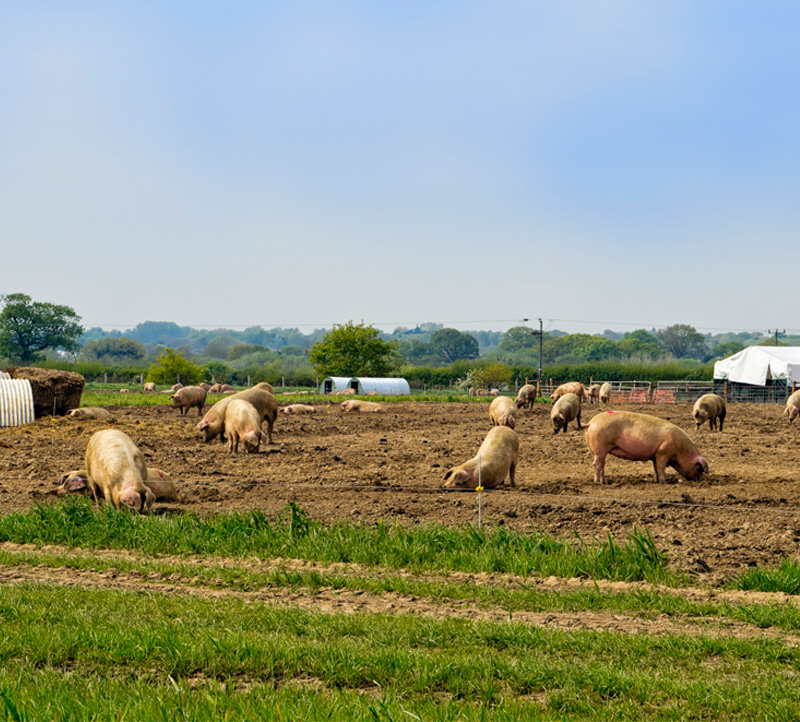This article includes:
- Everything you need to know to make your own raw dog food
- What to feed
- How much to feed
- Seven-day DIY feeding plan
- Shopping lists
- What to say to your butcher
There are several reasons why you may want to do this, including:
- To save money. Depending on what ingredients you use you could save as much as 33% and perhaps even more.
- To reduce packaging. Making your own reduce consumption of packaging and, if you use locally sourced ingredients, reduce ‘food miles’, too.
- For your personal satisfaction. It is always nice to feel that one has made something oneself.
You may be surprised that Honey’s – which is, after all, a dog food producer – should encourage you to make your own food and even show you how.
We are not like other producers!
So far as we are concerned the more dogs that are raw fed the better.
Our business has grown through word of mouth and we feel that if we give good service and good advice people will carry on recommending us.
If we can help you make your own food, great.
We can, by the way, supply you with all the ingredients you may require.
These are the same ethically sourced ingredients we use ourselves.
They are 100% British, fresh, sourced as locally as possible and come from free range, certified-organic and wild producers.
Three quick points before we get started:
- If your dog has (or has had) any serious health issues, it could make a difference to the raw diet you feed. In particular, if he or she has had recent surgery, suffered from digestive issues or currently has a compromised immune system, you should take advice from a vet or other expert (by all means call us) before you introduce raw food.
- Not all raw food diets are equal. A poor diet is always going to be a poor diet, regardless of whether the food is raw or processed. It is vital your dog receives the nutrition he or she requires. This article is pretty comprehensive but if you have questions do contact us.
You could also download our free book here: Honey’s Natural Feeding Handbook for Dogs. - High quality meat and vegetables contain much, much more nutrition and will lead to a much, much healthier dog. By the same token, low quality meat and vegetable could harm your dog’s health. We recommend using organic, wild and/or free range meat wherever possible. It has a much higher nutritional value and is worth the extra money.
A few words of reassurance
Switching a dog to a natural diet couldn’t be simpler and if you are concerned that raw feeding will be complicated, time-consuming, risky or expensive please put such thoughts right out of your mind:
- All you need to know to be successful is what ingredients are suitable for your dog and in roughly what proportions.
- With a little bit of planning it won’t take you any more time than opening a can.
- Dogs are biologically designed to eat raw food and it is 100% safe for them to do so (their stomach acids are so strong that they would burn your fingers).
- Your dog doesn’t need prime steak! He or she will thrive on all sorts of inexpensive ingredients, as explained below.
Unless your dog has certain health issues (see below), there’s no reason not to make a straight switch. Having said this, there are a few dogs (maybe 1 in a 100) who don’t take to natural feeding immediately, in which case you may find this article useful: Switching.
Incidentally, if you can withstand the looks of reproach it is no bad idea to fast your dog for a day before the switch. This will help your dog to rid its body of toxins built up while on a diet of processed food.
A simple three-step plan
Our straightforward feeding plan for adult dogs is a summary of decades of experience and it rests on three basic ingredients (all raw):
- meat
- bone
- vegetable
The plan itself can be distilled into three simple steps:
- Take any meat (chicken, beef, lamb, pork, whatever) minced or diced.
- Grate raw vegetables into it (anything but potato) so that it is roughly 2⁄3 meat and 1⁄3 vegetable (if you prefer, you can put the vegetable through a food processor).
- Get some meaty bones from the butcher and give your dog one every day or two. See our Bone guide for more information.
For portion sizes follow the instructions below. Vary the types of meat and vegetables you use.
That’s it.
What dogs need from their food and how they get it
Food has two core functions. It provides energy and it helps the body to remain healthy.
With regard to energy the amount required will depend on a variety of circumstances, including how old the dog is (growing dogs need more, elderly dogs less), the amount of exercise being taken, whether the dog is pregnant or feeding puppies and the temperature (weirdly, dogs in really hot climates can need more energy as panting uses up more calories than you’d imagine).
Interestingly, dogs do not need a lot of carbohydrates or simple sugars for energy (although a small amount of complex carbohydrate can provide useful fibre), as they can’t digest it easily.
Their core dietary requirements are fat (it provides energy and protection and it enables the body to absorb fat-soluble vitamins), essential fatty acids (Omega 6 and Omega 3), protein (with essential amino acids) and a wide range of minerals and vitamins.
What a dog needs for energy is obtainable in its natural diet. All processed dog food companies are trying to do is replace what dogs ought to be eating with low-quality, inadequate, adulterated and inappropriate ingredients.
Suitable ingredients
Below is a list of all the different things you can feed. An asterix (*) means that this is vital to your dog’s health. The other ingredients are more by way of providing additional nutrition.
- Lean muscle meat*
Chicken, beef, lamb, venison, rabbit, turkey, pork &c. Can be minced or diced.
- Internal organs*
Heart, lung, liver, tripe &c. Liver should never be more than 10% of the total diet. Don’t feed beef liver where the animal has been fed rape.
- Fish
Any fish but especially fatty fish such as herring, salmon, pilchards and sardines. If you can’t find fresh fish then once or twice a week you may like to add a tin of pilchards or herrings to the food.
- Dairy
Cheese, probiotic yoghurt, goat’s milk and/or small amounts of cottage cheese.
- Eggs
Any type of whole egg, as an egg two or three times a week is an excellent source of protein, vitamins and omegas.
- Bones*
Raw, meaty bones and including chicken/turkey carcasses.
- Leafy vegetables*
Spinach, winter greens, broccoli, cauliflower &c.
- Root vegetables*
Carrots, parsnips, swede, turnips &c. but not potatoes, which are high in starch.
- Fresh fruit
But not grapes or avocados and be sparing with dried fruits as they have a high sugar content.
- Vegetable extracts
Brewer’s yeast, kelp and/or a modest quantity of molasses.
- Extra oil*
Once or twice a week you may care to add some cod liver, safflower, hemp, flax seed or sunflower oil. You will notice that we are vague on the amount of, say, cod liver oil to add. Use your own judgement. For a small dog a teaspoonful will be enough, whereas for a really large dog you may like to add a tablespoonful.
Some useful tips
- The easiest way to meet your dog’s nutritional needs is to serve them meat, offal and vegetables in their bowl and give them raw, meaty bones on the side.
- There is no magic proportion when it comes to the percentage of meat, offal and vegetable. We recommend 2⁄3 meat and offal and 1⁄3 vegetable. Others will suggest that 90% meat and offal is better, with just 10% vegetable. Treat dogs as individuals and take their likes and dislikes into account.
- Any raw meat will do – beef, lamb, pork, chicken, rabbit, venison, tripe, squirrel – anything, in fact, so long as it comes from a reputable source.
- Grate in the vegetable or put it through your food mixer. Any vegetables will do, but not raw potatoes.
- Vegetables should always be fresh. Vegetables really begin to lose their nutritional value a week or so after they have been picked.
- Mix the ingredients up well, as some dogs have a small child’s aversion to vegetables.
- Don’t forget to buy your dog raw, meaty bones. These contain vital nutrients, ensure healthy teeth and keep their stools firm.
- If you are going to make your food up yourself, you will probably find it saves you a lot of time to prepare a decent supply in advance and freeze it. One good way to do this is to shape it into rough patties or hamburgers.
What to say to your butcher

Either way, it is much, much easier if you have plenty of freezer space.
When searching for a butcher, explain what you are doing and ask for:
- scraps
- inexpensive cuts
- raw, meaty bones
- green tripe – info below
- chicken and other carcasses
- offal (heart, kidneys and liver)
- mince (this should be ‘visually lean’).
With regard to the scraps and the mince, it is fine for it to have some fat in it, but it shouldn’t be too fatty (more than 30% fat would be a problem).
So far as inexpensive cuts are concerned, every butcher has their own ideas what these might be. Take ‘skirt’, which is the diaphragm under the ribs. Some butchers sell this for next to nothing; others know that there is good, lean meat to be had there and charge quite a bit for it. An efficient butcher will find you inexpensive ways to feed your dog.
Note that raw chicken carcasses and ‘backs’ are perfect for dogs and some people feed their dogs almost nothing else. Chicken wings are also great, a perfect parcel of meat and bone.
Some people feel it is important that the meat they buy for their dogs is suitable for human consumption. Others don’t. The truth is the dogs are unlikely to mind if it is a bit smelly and you shouldn’t be too obsessed with the ‘best before’ date.
If you’re looking for a convenient supply of ethically sourced meat and bones remember Honey’s can supply you. We estimate that our DIY customers save about 33% compared to our complete food customers.
How much to serve
To begin with, you’ll need to monitor the quantity of food quite closely but once you get the hang of it, providing your dog is about the correct weight and looks fit, you can do it by feel.
Lots of successful raw feeders simply watch their dogs carefully and adjust the quantity as they go.
There is no hard-and-fast rule but for a dog over 10kg roughly 2% of their body weight in food (including edible bones) every day should be about right.
In other words, a 20kg dog should be eating roughly 400g.
If you have a working dog, an underweight dog or a dog that exercises a great deal then up this amount to between 2% and 5% of body weight per day.
If you have an elderly or overweight dog then reduce the amount to between 1% and 2% of bodyweight per day.
You can serve it in as many meals as you want and at whatever time, but it should never be left down for the dog to eat when he or she feels like it.
You might be interested to know that because wolves exercise so much they need about three times as much food as a typical dog.
For dogs under 11kg in weight try:
- 1–2kg: 10% of bodyweight
- 3–4kg: 7% of bodyweight
- 5–8kg: 5% of bodyweight
- 9–10kg: 3% of bodyweight
- 11kg+: 2% of bodyweight
If you’d like more detailed advice please get in touch with us. These percentages are for guidance only.
How to tell if your dog is the correct weight
The easiest way to tell if your adult dog is the right weight is to make sure that your dog’s ribs are easily noticeable.
Of course, for a hairy dog this isn’t so easy!
In this case run your hands over the rib cage.
If it is easily felt, your dog is the right weight.
If there is any fat… he or she needs to go on a bit of a diet!
The pros and cons of green tripe
If there were only one ingredient you could feed your dog, it would have to be green tripe.
Nothing else offers such a variety of digestible proteins and your dog would thrive if fed nothing else.
What is it?
The dictionary defines it as: ‘the raw, unbleached stomach of cattle or other ruminants, after no other treatment than a simple rinse in cold water’.
It is called green because it has a green, fluorescent shine to it, although in colour it tends to be anything from light brown to black.
From a dog’s perspective it is almost a wonder food, but from a human’s perspective it has a couple of potential drawbacks.
To begin with, it contains a great deal of bacteria, some of which may be harmful to humans (but not dogs).
For this reason, it can’t be kept in the same fridge or freezer as food for human consumption.
It must be handled and served carefully so that no contamination occurs.
If you have any cuts or grazes on your skin you shouldn’t touch it as it can lead to infection.
Then there is the smell.
This is not only strong but also lingers.
It’s not a bad smell when you get used to it, but it’s a devil to wash off and so it really is best to handle tripe using rubber gloves.
In short, it is a nuisance to deal with but well worth the effort if you can be bothered, especially as it is relatively inexpensive.
One final point, at Honey’s we sell tripe that has been washed in plain water.
It is not as good as green tripe but a less bothersome alternative and 100% safe for human handling.
Please don’t support intensive farming
For the most part farm animals lead short, painful lives in appalling conditions.
They are kept indoors, in tiny cages, mutilated and transported hundreds and even thousands of miles before being killed.
Furthermore, the way they are slaughtered is invariably drawn out and cruel.
The photographs and imagery used by farmers, producers, food manufacturers, butchers, marketing boards and supermarkets create, by and large, entirely the wrong impression.
Only a tiny percentage of farm animals lead relatively happy and natural existences.
Unless the meat you buy meets certain criteria, the chances are that it has been intensively reared.
To buy it is to support cruelty to animals.
Of course, it is cheaper than meat from compassionately farmed animals: having a conscience does cost a little bit extra.
But if you love animals, it is money well spent.
What’s more, intensively reared meat is much more likely to be packed with harmful chemicals since intensively farmed animals are given many more drugs to keep them alive.
To ensure that the meat you are buying has not been intensively reared insist that:
- Chicken, pork and turkey is free range or certified organic.
- Rabbit, game birds and venison are wild.
- Lamb and beef have been grass/pasture fed or are free range or organic.
If you are buying organic meat, providing it is properly certified, you can be confident that it has been reared with animal welfare in mind.
It is much better for the environment and less wasteful to buy British.
Also, beware of labelling. Ridiculous legislation allows businesses to buy chickens in, say, Thailand but by cunning means describe them as being British.
If you would like to learn more about intensive farming, you might like to contact: Compassion in World Farming (www.ciwf.org.uk), which was started by an ordinary British farmer; the World Society for the Protection of Animals (www.wspa.org.uk), a leading pressure group; and/or the Soil Association (www.soilassociation.org), the UK’s leading campaigner for higher standards of animal welfare.
Why fasting is good for your dog’s health
From start to finish it can take a dog anything up to 20 hours to digest a full meal, a full meal being the amount it can fit in its stomach at a single sitting.
This is a very long time when compared to humans, who eat much smaller meals and digest them much faster.
Why is the time it takes a dog to digest important?
Because a dog’s digestive system needs to rest for periods to operate at optimum efficiency.
More than this, if the system doesn’t get a chance to rest it can be harmful to the dog’s health (it needs the time for its liver to transform fat to glucose).
Our advice is to feed your dog once a day, never to leave food down for it (eat it or lose it being the rule) and to fast your dog at least once a week.
Achieving balance
Dogs don’t eat completely balanced meals in the wild, but get the nutrition they need over time.
You don’t, therefore, have to worry too much about balancing each meal you feed.
Rather, you should be thinking about the balance over a week or even a month:
- The meat, organs and bones should account for no less than 2⁄3 of your dog’s diet.
- Provide plenty of variety: it ensures your dog is getting all the nutrition it needs from different sources.
- Your dog shouldn’t really need extra supplements, but if you decide to give them be sparing and watch for the effects.
Unless you have a dog with a serious health issue, there is no reason to worry about the exact nutritional value of each element of your dog’s natural diet.
A word about hygiene
Dogs may have stomach acids so strong that they would burn your fingers, but humans don’t.
Raw food does have bacteria on it that could cause health issues for humans.
Keep it separate from the food you are going to eat, thoroughly wash any surface it comes into contact with (including utensils, storage containers and so forth) as well as your hands.
Use an anti-bacterial soap or mild disinfectant and/or wear rubber gloves.
If you don’t want to use harmful chemicals, vinegar is a natural alternative.
The golden rules
- The main objective is to feed your dog a species appropriate diet. What would he or she eat in the wild? You want to re-create the same sort of diet using tame ingredients.
- The optimum diet for dogs consists of muscle meat, bone, offal, vegetables and fruit – all raw. Some people also favour adding ‘boosters’ such as eggs, fish, some dairy (such as cheese or yoghurt), oils and herbs.
- It is generally considered better to stick to a single source of protein (say all chicken or all beef) at each meal.
- Variety is important. It is important that your dog receives his or her nutrition from lots of different sources. Use meat from different animals. Use different parts of the animal. Use seasonal vegetables.
- In the wild dogs do not attempt to meet all their nutritional requirements in a single meal or even a single day. There is no need to balance every meal – just balance it over time i.e. a few days/a week.
- Never feed your dog: raisins, sultanas, dried fruit, avocado, grapes, macadamia nuts, onions, persimmons, peaches or plums. Garlic is only recommended in very small quantities (and not just because of their breath!).
- If your dog is new to raw food you may prefer to make the switch slowly. This allows their bodies time to adjust to the new ingredients.
Typical 7-day DIY feeding plan for a healthy dog
- Raw lean muscle meat and organs
- Raw meaty bones
- Raw vegetables and fruit
- Boosters
Sunday
- Minced Chicken
- Chicken carcass with no meat
- Cabbage, broccoli and apple
- Egg
Monday
- Cubed pork
- Pork ribs
- Carrot and cauliflower
Tuesday
- Minced duck
- Duck neck
- Spinach mangetout and banana
- Sardine
Wednesday
- Beef Knuckle bone
Thursday
- Ox heart
- Small marrow bone
- Pumpkin, celery and blueberries
- Hempseed oil
Friday
- Duck back and wings
- Kale and red pepper
Saturday
- Whole rabbit
- Live yoghurt
Shopping list – main ingredients
- Beef heart (aka Ox)
- Ox tongue
- Tripe
- Lean minced or cubed chicken
- Chicken hearts
- Chicken carcasses (also known as chicken backs)
- Chicken wings
- Lean minced or cubed duck
- Duck carcasses (also known as duck backs)
- Duck wings (remove the skin)
- Lean minced or cubed turkey
- Turkey hearts
- Lamb heart
- Lean minced or cubed goose
- Lean minced or cubed pork
- Pork tongue
- Venison meat and heart
- Beef marrow bones (the knuckle ends are best)
- Lamb mince
- Beef mince
- Whole rabbit, gutted, feet removed, without their heads
- Goose carcasses (remove the skin)
- Liver
Shopping list – ‘booster’ ingredients
Choose ONE item from this list and add it a few times a week. These ‘boosters’ are not vital to the diet, but help to ensure that your dog receives a wide range of nutrients.
Eggs
One egg for a small or medium sized dog. Two eggs for a very large dog.
Sardines, mackerel or pilchards
In spring water with no salt added or oil. Add one fish for a small dog, two or three for a medium sized dog and a whole tin for a large dog.
Hempseed oil
One teaspoon.
Chia seeds
One teaspoon.
Live yoghurt
One tablespoon for every 10kg your dog weighs.
Shopping list – vegetables and fruit
Pretty much anything goes providing you avoid the ingredients listed as unsuitable above.




